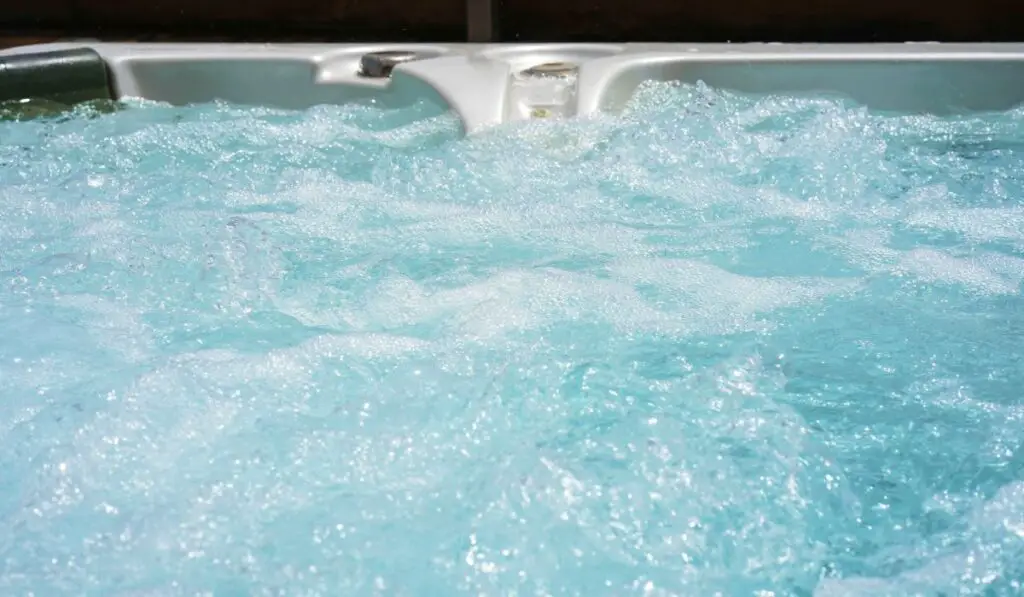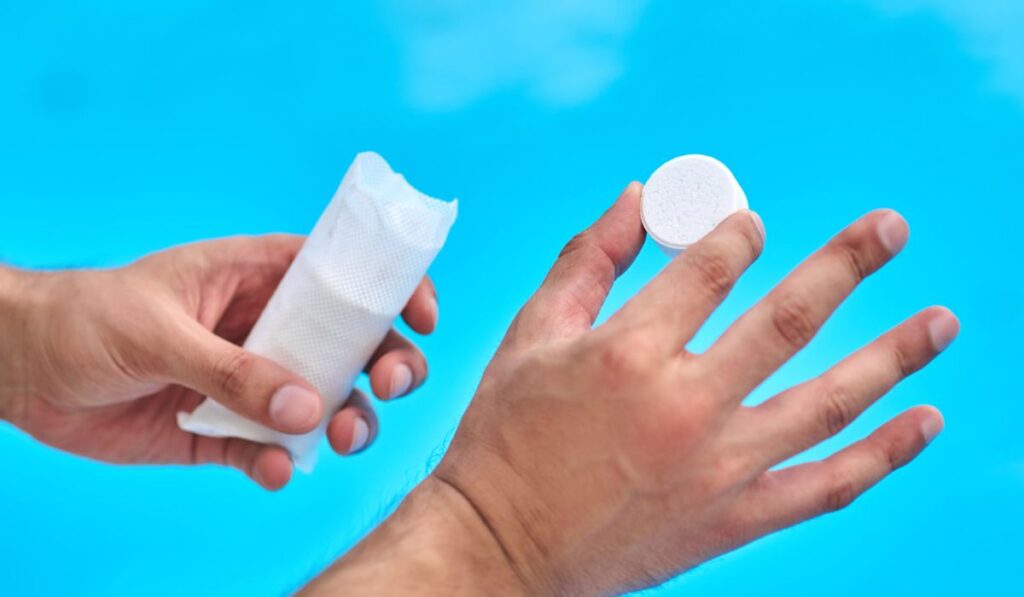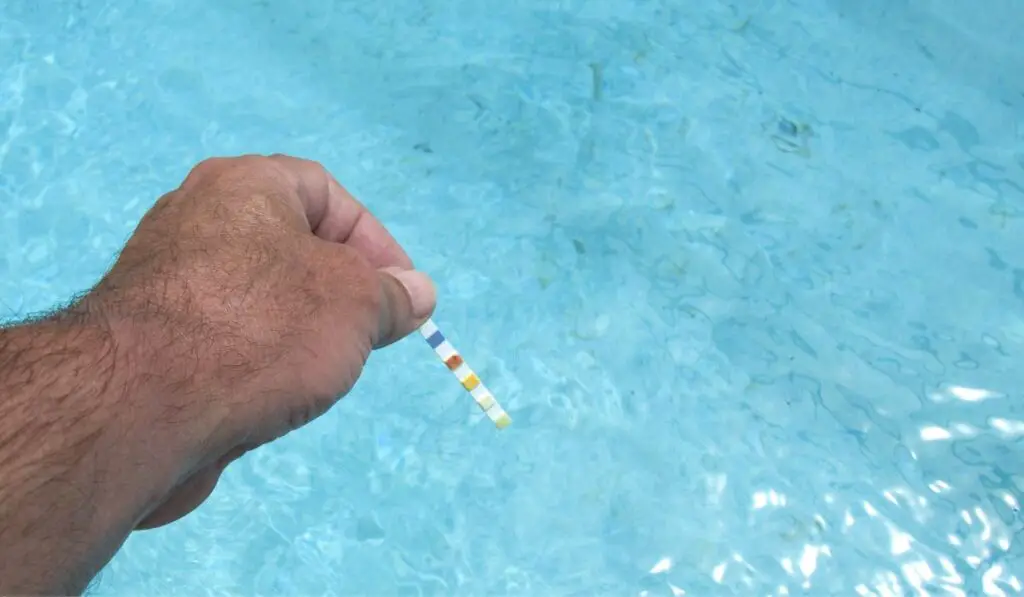pH and alkalinity in any treated water go hand in hand. When one rises, the other will almost always follow, so it can be tricky if you are looking to only change one. The best course of action when it comes to leveling out your hot tub levels is to look to adjust either the pH or the alkaline and hope the other will follow.
The alkaline readings for your hot tub should fall between 80-120ppm. If the levels are too high, you can try adding sodium bisulfate or muriatic acid to the water to lower the alkalinity. Unfortunately, the pH will also likely drop. There is no way to change one without changing the other.
High alkalinity can cause these kinds of damage, just like acidity can, which is why it’s important to lower it. Let’s look at how you can lower the alkalinity in your hot tub and what it will do to your pH.
What is Alkalinity?

Alkaline water is the measurement of the hot tub’s ability to neutralize acids. It is basically how soft the water is. It’s an important part of balancing the pH levels and is sometimes referred to by professionals as the buffer, because it helps the water resist those drastic changes in pH. You want your hot tub’s alkalinity to be between 80-120ppm.
Most people seem to only worry about acidity in their hot tub water, and ignore the adverse effects of not having the appropriate alkalinity readings. However, there are a few issues that can occur when your hot tub gets the incorrect reading of alkalinity, just like if it becomes too acidic. For instance, it can turn the water green and have a severe drying effect on your skin.
Low alkalinity is a more serious issue than having too much. Along with turning the water green, it can have rapid fluctuations in the pH because the water can no longer counteract the effects of any acids such as minerals, chemicals, or other substances that might come in contact with your water. Even your body can trigger these fluctuations.
If low alkalinity levels are left unchecked they can even start to corrode your hot tub’s internal equipment.
On the other side of things there is an alkalinity level that is too high, which also has its own set of adverse effects. Like low alkaline levels, it turns the water green but also reduces the effectiveness of your sanitizer, making the water unhealthy to swim in and a breeding ground for bacteria.
What is pH?
pH is the level of measured acidity and alkalinity in water on the pH scale. The pH scale is from 0 to 14, with a measurement of 7 being balanced or neutral. When it comes to hot tubs, you want to keep your pH levels between 7.2 and 7.8 to maintain healthy water levels that won’t damage your hot tub or harm your body.
If you are getting levels below 7.2 that means that your water is too acidic, which can cause itchiness and burn your eyes, but it can also cause your hot tub equipment to corrode and even neutralize any sanitizer you use, making the water develop dangerous levels of bacterial growth.
With measurements coming in above 7.8, that means that your water has too much alkalinity, which can contribute to scale growth, foam, and green cloudy water. So it’s important to regularly check your pH and make sure it is always coming in between 7.2 and 7.8, else you will need to adjust the chemicals in your water.
Can You Lower the Alkalinity in a Hot Tub Without Lowering the pH?
Unfortunately, you can’t change one without affecting the other. Alkalinity and pH go hand in hand together, and if one is high, the other will be too, and vice versa. Their relationship can’t be altered, and always follow each other.
Since alkalinity acts as a buffer to the pH, and it tries to prevent it from lowering, it gives the water the ability to neutralize acids. So to lower your pH reading, you need to lower the alkalinity as well. The best way to do this in hot tubs or pools is to use sodium bisulfate or muriatic acid, which generally decreases alkalinity and, in turn, will reduce your pH.
Considering both of these chemical compounds are acids, it is always best to wear gloves and eye protective gear to prevent any damage to your skin or eyes.
By adding these acids to the water, it will convert the bicarbonates that make up the alkalinity in your water to carbonic acid, or H2CO3, also known as dissolved CO2. This will ultimately lower your pH levels, but keep in mind the higher the alkalinity in your hot tub, the more acid you will need to use to reduce that pH.
How to Prevent Your Alkalinity From Rising
Since prevention is key when running a hot tub, it is a good idea to know how to stop your alkaline levels from getting out of hand before they are getting those dangerous levels above 120ppm.
Since preventing those alkaline levels from rising is only doable by preventing your pH from rising, there are a few things to consider that both affect your pH and, in turn, your alkaline readings.
Shock Your Water
The first method to prevent both alkalinity and pH from rising is to regularly shock your water. This will kill any algae growth, which is not only a healthy practice for your body since algae baths are not recommended, but it is also good for the hot tub.
Algae can cause bacteria overgrowth on its own, but in terms of pH readings, it does consume carbon dioxide. With not enough carbon dioxide in the water, your pH will begin to rise, and so will the alkaline levels.
Turn Off Your Jets
Since water aeration makes your pH rise, it is always a good idea to turn off your jets or other water features that can cause surface agitation when they are not in use.
The water aeration from these features causes the carbon dioxide to dissipate into the air, making the water more acidic and the pH rise. Turning off the jets to your hot tub when you aren’t using it not only saves electricity but can also help prevent these passive carbon dioxide losses.
Use Low pH Chlorine Tablets

Another way to prevent pH from needlessly rising is to use low pH chlorine tablets when needed to help clean the hot tub. These will help keep the pH lower and are simple to use.
Alternatively, never use high-pH household products such as borax or baking soda. They make great cleaning products inside the home, but never for a hot tub, as they can have adverse effects on the pH and alkaline readings of the water.
Fill Your Hot Tub With Low pH Water
Lastly, try using lower water pH when filling up your hot tub. Not everyone has this kind of choice, since most people tend to fill from a hose, but if you do, it is always a good idea to start on the lower end of the pH ratings between 7.2 and 7.8 rather than starting high and ending up needing to correct a whole host of issues shortly after.
Make sure to always test your water after filling your hot tub, and don’t just assume it is good.
How Often Should You Test Your Hot Tub’s Alkalinity?
It is a good practice to test your hot tub water frequently, and most experts tend to suggest doing so at least once a week, ideally when it is being heated. However, there is no golden rule for how often it should be tested.
If the hot tub has seen a lot of activity lately, then always check the water more frequently, as the bodies of its users can drastically change its levels, from suntan lotions, moisturizers, or simple body oils–everything can shift the water’s pH readings.
Always check the water after it has been cleaned, filled, or treated, just to make sure that it is still reading at appropriate levels, even if you did so shortly before. It’s better to waste two minutes than leave an issue unchecked that could cause bodily harm and physical damage to the hot tub later on.
How to Test Your Hot Tub’s Alkalinity and pH

Testing your hot tub’s alkalinity and pH levels is surprisingly easy, given it needs to be done so frequently. Dip test strips (on Amazon) are cheap, easy to use, and have multiple uses in one package.
They tend to measure pH, total alkalinity, and sanitizer levels, the three main points of interest when looking at your water levels.
The test strips are easy to use, simply dunk them in the water for the package-specified time and wait for the colored squares to turn to their indicated levels. Instructions are on the package and can vary slightly from brand to brand.
